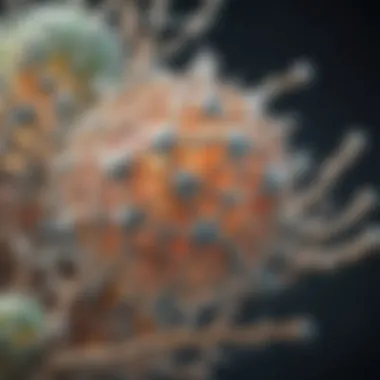The Multifaceted Role of Lysozyme in Biological Systems


Intro
Lysozyme is an enzyme present in various organisms, including plants, animals, and bacteria. Its primary function is to degrade polysaccharides in the cell wall of bacteria, thus playing a fundamental role in innate immunity. This article explores the multifaceted roles of lysozyme in biological systems, illuminating its structural characteristics, mechanisms of action, and practical applications. Understanding lysozyme is essential, as it contributes significantly to health and disease management.
Methodology
Overview of Research Methods Used
To delve into the diverse aspects of lysozyme, a variety of research methods have been utilized. These include biochemical techniques, molecular biology approaches, and bioinformatics analyses. Studies often employ enzyme assays to assess lysozyme activity under different conditions, revealing its functional properties. Structural analysis through X-ray crystallography and NMR spectroscopy provides insight into its three-dimensional conformation, offering a glimpse into how structure influences function.
Data Collection Techniques
Data collection on lysozyme encompasses various techniques:
- Experimental Data: Laboratory experiments yield direct measurements of lysozyme activity and stability across conditions.
- Literature Review: A thorough examination of existing research provides context and identifies gaps in knowledge regarding lysozyme's roles.
- Clinical Studies: Observations from clinical trials help in understanding the therapeutic implications of lysozyme in treating infections and other diseases.
Through these methods, researchers gain a comprehensive view of lysozyme's functionality and its significance in biological systems.
Structural Characteristics of Lysozyme
Lysozyme has a compact structure, primarily comprised of alpha-helices and beta-sheets. This specific arrangement allows it to effectively bind to its substrate, facilitating the breakdown of peptidoglycan, a critical component of bacterial cell walls. The enzyme's active site is highly specific, allowing it to work efficiently against a wide range of Gram-positive bacteria.
Mechanism of Action
Lysozyme operates through a well-defined mechanism. The enzyme binds to bacterial cell walls, where it hydrolyzes glycosidic bonds. This action disrupts the integrity of the bacterial cell wall, leading to cell lysis. The activity of lysozyme is influenced by factors such as pH and temperature, making the understanding of its environment crucial for optimizing its function.
"Lysozyme serves as a natural defense mechanism, illustrating the intricate relationships between biochemistry and immunity."
Relevance to the Immune System
In the immune system, lysozyme acts as a first line of defense against pathogens. It is present in various bodily secretions, such as tears, saliva, and mucus, thereby protecting mucosal surfaces from invasion. Additionally, lysozyme's potential to modulate immune responses is garnering attention in immunology research, highlighting its capabilities beyond mere antibacterial action.
Potential Therapeutic Implications
The therapeutic applications of lysozyme are expanding. It has been investigated for its role in treating bacterial infections, particularly those caused by antibiotic-resistant strains. Furthermore, lysozyme's anti-inflammatory properties suggest its potential for use in managing conditions such as rheumatoid arthritis and gastrointestinal disorders. Ongoing research aims to refine its application in medicine, indicating a shift towards personalized therapeutic strategies.
Future Directions
Upcoming Trends in Research
Future investigations surrounding lysozyme will likely focus on its functional versatility and mechanistic pathways. The influence of lysozyme on the microbiome and its relationships with other enzymes in immune responses are particularly promising areas of study. Integrating lysozyme into novel therapeutic frameworks may enhance treatment efficacy against infections.
Areas Requiring Further Investigation
Despite significant advancements, several areas concerning lysozyme remain underexplored. Understanding the enzyme's interactions with various substrates could yield important insights into its broader biological roles. Moreover, research should aim to elucidate the gene regulation of lysozyme synthesis in different organisms, which could have implications for both ecology and evolution.
The End
Lysozyme exemplifies a crucial enzyme in biological systems, underpinning various physiological processes from innate immunity to potential therapeutic applications. As research continues, an expanded understanding of this enzyme may significantly impact health and disease management strategies.
Prelims to Lysozyme
Lysozyme is a crucial enzyme found in various biological systems, serving essential functions such as protecting against bacterial infections and aiding in the immune response. Understanding lysozyme's multifaceted role is key to appreciating its importance in both physiological processes and potential therapeutic applications. This section aims to lay the foundation for examining lysozyme in detail, starting from its definition to its historical context.
Definition and Discovery
Lysozyme, first discovered in 1922 by Sir Alexander Fleming, is an enzyme that catalyzes the breakdown of certain polysaccharides found in bacterial cell walls. Its primary function is to hydrolyze the glycosidic bonds between sugar molecules in peptidoglycan, leading to bacterial cell lysis and ultimately their death. This antibacterial property is significant in various organisms, ranging from humans to plants.
Initially isolated from egg whites, lysozyme was later found in numerous other tissues and secretions, including tears, saliva, and mucus. Its discovery marked a pivotal moment in microbiology and immunology as it showcased how the body can employ enzymes as a defense mechanism against pathogens.
Historical Context
The exploration of lysozyme's role has evolved significantly since its initial discovery. In the early 20th century, scientists were intrigued by how this enzyme could contribute to immune defense. Research expanded over the decades to investigate its presence across different species, demonstrating that lysozyme is not exclusive to any single organism.
Notable milestones in lysozyme research include the characterization of its structure, elucidated through X-ray crystallography in the 1960s, which helped scientists grasp its function better. Studies have established that lysozyme's presence extends beyond animals, being found in various plants and microorganisms, indicating an evolutionary advantage in multiple ecological niches.
Today, ongoing research continues to uncover the complexities of lysozyme's biological roles, including its potential in various applications, such as food preservation and pharmaceuticals. Understanding lysozyme's historical context enriches our knowledge of its significance in present-day biological systems.
Chemical Structure of Lysozyme


The chemical structure of lysozyme is critical to understanding its numerous functions and roles in biological systems. Lysozyme, as an enzyme, exhibits a specific configuration that directly influences its activity and interactions with other molecules. Recognizing these structural nuances provides insights into how lysozyme exerts its antibacterial properties, participates in immune responses, and potentially impacts health and disease.
Amino Acid Composition
Lysozyme is primarily composed of amino acids, with a typical structure featuring 129 residues that form a compact globular protein. The amino acid sequence is highly conserved across species, suggesting an essential role in lysozyme’s function. The key amino acids include:
- Glutamic Acid: Plays a vital role in the catalytic site, helping in bond cleavage of the peptidoglycan in bacterial cell walls.
- Aspartic Acid: Along with glutamic acid, assists in the catalytic process, stabilizing transition states during enzymatic action.
- Serine: Contributes to the catalytic triad, vital for lysozyme's hydrolytic activity.
Additionally, the distribution of polar and nonpolar amino acids affects its solubility and interaction with the aqueous environment within biological systems. This composition not only defines the structural stability of lysozyme but also its reactivity with substrates, thus playing a fundamental role in its function.
Three-Dimensional Conformation
The three-dimensional conformation of lysozyme is shaped by the interactions among its amino acid residues, leading to a specific folding pattern that is crucial for its enzymatic activity. Lysozyme's structure is characterized by its tight packing, which decreases the likelihood of denaturation under physiological conditions. This conformation comprises six alpha-helices and several beta-sheets, forming a unique active site conducive to substrate binding.
The active site is the heart of the enzyme, where the substrate binding occurs, triggering the catalytic action. The specific arrangement of side chains and peptide backbones within the active site determines substrate specificity. This configuration allows lysozyme to effectively hydrolyze the glycosidic bonds in the peptidoglycan layer of bacterial cell walls, resulting in cell lysis.
"Understanding the three-dimensional structure of lysozyme is crucial for biotechnological applications where manipulation of its activity is desired."
In summary, the chemical structure of lysozyme, highlighted by its amino acid composition and three-dimensional conformation, plays a pivotal role in its biological functionality. This knowledge not only enhances comprehension of its natural roles in organisms but also paves the way for innovations in its application across various fields such as medicine and food technology.
Mechanism of Action
Understanding the mechanism of action of lysozyme is essential for appreciating its vital roles in various biological systems. This section uncovers how lysozyme interacts with its substrates, its catalytic efficiency, and its regulation within the body. By examining these elements, one can gain insight into how lysozyme contributes to immune responses and overall health.
Substrate Specificity
Lysozyme exhibits a distinct substrate specificity, which refers to its ability to identify and bind specifically to certain molecules. It primarily targets peptidoglycans found in bacterial cell walls. The enzyme cleaves the glycosidic bonds in these complex carbohydrates, leading to cell lysis and bacterial death. This action underscores lysozyme's crucial role as a first line of defense in the immune system.
The enzyme's active site is tailored to recognize substrates with specific structural characteristics. For example, the orientation of the carbohydrate moieties influences binding efficiency. Small variations in the structure of target molecules can affect how well lysozyme can interact with them, establishing a selective advantage in microbial defense.
Catalytic Process
The catalytic process of lysozyme involves a series of precise biochemical reactions. When a substrate molecule binds to the active site of lysozyme, it undergoes a transformation. The enzyme catalyzes a hydrolytic reaction, breaking the β-1,4-glycosidic bond in the peptidoglycan. This process involves the formation of an enzyme-substrate complex and ultimately results in the release of oligosaccharides.
Key amino acids play critical roles in this catalytic mechanism. Glutamic acid and aspartic acid are often involved in proton transfer, helping to cleave the bond efficiently. The efficiency of this process is influenced by factors such as pH and temperature. A deeper understanding of this process has potential implications for designing targeted antibacterial therapies.
Inhibition and Regulation
Like many enzymes, lysozyme is subject to inhibition and regulation. Various factors, such as the presence of ions or competitive inhibitors, can affect its activity. For example, high concentrations of certain ions can either enhance or inhibit lysozyme’s action. It is important to note that the regulation of lysozyme is not solely based on external substances.
The expression of lysozyme itself can be regulated by different physiological conditions. For example, cytokines involved in the immune response can upregulate lysozyme production during an infection. This adaptive response ensures that lysozyme levels match the body's needs during periods of heightened immune activity.
“The mechanisms through which lysozyme operates highlight its intricate relationship with the immune system, making it a focal point for further research in immunology.”
In summary, the mechanisms underpinning the action of lysozyme are critical to its effectiveness in fighting infections and maintaining homeostasis within biological systems. Recognizing substrate specificity, the catalytic process, and the conditions for inhibition and regulation provides a comprehensive understanding of how this enzyme operates.
Biological Functions of Lysozyme
Lysozyme has several important biological functions that contribute to the overall functionality and resilience of various organisms. Understanding these roles provides insight into the enzyme's significance in health and disease, revealing how it shapes immune responses and influences pathogen interactions. Its multifunctionality makes it a target of interest in biomedical research and biotechnology applications.
Role in the Immune Response
Lysozyme plays a crucial role in the immune response by acting as one of the first lines of defense against microbial attacks. It is present in various bodily fluids, including saliva, tears, and mucus. The enzyme attacks the peptidoglycan layer of bacterial cell walls, leading to lysis or the disintegration of these harmful cells. This activity is vital for preventing infections, particularly at mucosal surfaces where pathogens often enter the body.
The immune response is complex, and lysozyme’s role is pivotal during the innate phase. It not only kills bacteria but also aids in the modulation of immune responses. For instance, lysozyme can influence the activities of other immune cells, enhancing their ability to detect and eliminate pathogens. It’s a key player in maintaining homeostasis by limiting excessive inflammation.
Antibacterial Properties
Lysozyme exhibits significant antibacterial properties that contribute to its effectiveness in combating infections. As a bacteriolytic enzyme, it specifically acts on the glycosidic bonds in peptidoglycan, which is a structural component of bacterial cell walls. When lysozyme cleaves these bonds, it compromises the integrity of the bacterial wall, leading to osmotic imbalance and cell rupture.
- The effectiveness of lysozyme varies with different bacteria. It is particularly effective against Gram-positive bacteria due to their thick peptidoglycan layers.
- Some Gram-negative bacteria, however, possess an outer membrane that protects them from lysozyme, demonstrating the nuanced nature of antibacterial action.
- Lysozyme’s presence in human saliva can rapidly assist in controlling oral bacterial populations, thus contributing to oral health.
Impact on Pathogen Survival
Lysozyme's impact on pathogen survival emphasizes its essential function in the host's defense mechanisms. By attacking invading bacteria, lysozyme directly influences pathogen population dynamics. This action can effectively reduce the load of pathogens at infection sites, decreasing the likelihood of disease progression.
The relationship between lysozyme and pathogens can be complex. While lysozyme serves as a deterrent for many bacteria, some pathogens have developed resistance mechanisms. For example, certain bacteria can modify their cell wall structures to circumvent lysozyme action.
"Understanding the roles of enzymes like lysozyme in pathogen survival is crucial for developing new strategies in infectious disease management and therapy."


In summary, lysozyme's functions are integral to the immune response and exert significant antibacterial influence, affecting pathogen survival. These functions showcase the enzyme's importance in maintaining health and offer avenues for potential therapeutic interventions.
Lysozyme in Different Organisms
Lysozyme's role is not confined to a single biological realm. Its presence across various organisms highlights its evolutionary significance and functional versatility. Understanding lysozyme in different organisms can provide valuable insights into its adaptive functions, and ecological roles, and how it may be harnessed for biotechnological applications. This section will explore the manifestations of lysozyme in animals, plants, and microorganisms, illustrating the enzyme's unique adaptations in each domain.
Lysozyme in Animals
In the animal kingdom, lysozyme is predominantly found in secretions and plays a pivotal role in innate immunity. This enzyme breaks down the peptidoglycan layer of bacterial cell walls, contributing to the defense against infections. For vertebrates, lysozyme is especially abundant in saliva, tears, and milk.
Key Points about Lysozyme in Animals:
- Source: Sources range from organs such as the salivary glands to immune cells like macrophages.
- Functionality: Lysozyme roles include protecting against pathogenic bacteria and aiding in digestion in some species.
- Variety: Various forms of lysozyme exist among different animal species, reflecting evolutionary adaptations to specific environments and pathogens.
For instance, in humans, lysozyme levels are notably higher in the respiratory tract, illustrating its role in protecting against airborne pathogens. This adaptability suggests that lysozyme not only acts as an antibacterial agent but may also have additional functions in modulating immune responses.
Lysozyme in Plants
Plants also synthesize lysozymes, but their functions often extend beyond antimicrobial activity. In plant systems, lysozymes are involved in defense mechanisms against environmental stress and pathogen attack. Their presence is often indicated by increased activity following an infection or physical injury.
Key Points about Lysozyme in Plants:
- Diversity: Different plant species express varied lysozyme isoforms that correspond to specific pathogenic challenges.
- Protection: Lysozymes contribute to the systemic acquired resistance in plants, working alongside other defensive compounds to mount a cohesive defense.
- Impact: Studies indicate that transgenic plant varieties engineered to express higher levels of lysozyme show increased resistance to certain pathogens.
Such findings underscore the feasibility of utilizing lysozyme as a genetic tool in agriculture to enhance crop resiliency against diseases and pests.
Lysozyme in Microorganisms
Microorganisms, primarily bacteria and fungi, exhibit a divergent use of lysozyme. While they may produce lysozyme-like enzymes as part of their immune systems, others can even develop resistance through mutations.
Key Points about Lysozyme in Microorganisms:
- Host-Pathogen Interactions: Many pathogenic microorganisms produce lysozyme-inhibiting factors that confer survival against host defenses.
- Evolutionary Arms Race: This interaction has led to an evolutionary arms race between hosts producing lysozymes and microscopic pathogens evading them.
- Applications: Lysozymes from microorganisms can be exploited for biotechnology, especially in the development of antimicrobial agents that can be commercialized for health and food applications.
Applications of Lysozyme in Biotechnology
Lysozyme holds a central position in the realm of biotechnology due to its diverse and impactful applications. It is not just a mere enzyme; its versatility in various sectors makes it an essential component in both research and industry. This section explores the applications of lysozyme, specifically focusing on food preservation, pharmaceutical uses, and its potential in cancer treatment.
Food Preservation
The application of lysozyme in food preservation is notably significant. Lysozyme acts as a natural preservative due to its antibacterial properties. It has the ability to break down the cell walls of bacteria, thus inhibiting their growth. This feature is particularly useful in prolonging the shelf life of food products, especially those that are prone to spoilage.
- Natural Alternative: Lysozyme is preferable to synthetic preservatives, offering a cleaner label for consumers.
- Efficacy: This enzyme is especially effective against gram-positive bacteria, which are commonly associated with food spoilage.
- Applications: It is used in various food products including cheeses, baked goods, and liquid eggs to maintain freshness and safety.
By employing lysozyme, food manufacturers can ensure product quality while adhering to consumer demand for healthier options.
Pharmaceutical Uses
In the pharmaceutical industry, lysozyme plays a crucial role. Its antimicrobial properties make it valuable in formulations aiming to combat infections. Lysozyme is often incorporated into topical ointments and eye drops, enhancing their effectiveness by eliminating harmful bacteria.
- Therapeutic Agent: It has applications in formulations designed for wound healing and respiratory treatments, where bacterial infection is a concern.
- Anti-inflammatory Properties: Recent studies suggest that lysozyme may possess anti-inflammatory effects, adding another dimension to its utility in medications.
- Safety and Compatibility: Being a naturally occurring enzyme, it typically has a favorable safety profile, making it suitable for various patient populations.
Potential in Cancer Treatment
The exploration of lysozyme's potential in cancer treatment is an exciting frontier in medical research. Studies are increasingly focusing on its ability to modulate immune responses and its direct effects on tumor cells.
"Lysozyme may enhance the body’s own defenses against cancer by promoting apoptosis in malignant cells."
- Immune Modulation: Lysozyme may improve the immune response, enhancing the body's ability to fight against tumors.
- Direct Antitumor Activity: Research suggests that lysozyme can have direct effects on cancer cells, inducing cell death through mechanisms that warrant further investigation.
- Combination Therapies: The enzyme shows promise in combination with traditional cancer therapies, potentially improving efficacy while reducing side effects.
Comparative Analysis of Lysozyme
The comparative analysis of lysozyme is fundamental for understanding its various roles across different biological systems. By examining the structural and functional variations of lysozyme among species, researchers can gain insights into its evolutionary significance and adaptability. This analysis also informs the potential applications of lysozyme in biotechnology and medicine. Identifying how lysozyme differs in its effectiveness and specificity across organisms can lead to the discovery of novel therapeutic uses or enhancements in food preservation techniques. Moreover, these comparisons help to highlight the enzyme's conserved features that are crucial for its core functions, such as antibacterial activity and immune response.
Lewis Structure Comparison
The Lewis structure of lysozyme provides a visual representation of its molecular framework. Understanding this structure is significant as it displays the arrangement of atoms and the distribution of electrons within the enzyme. This information is essential for illustrating how lysozyme interacts with its substrates. Notably, the arrangement of functional groups within the structure can dictate enzymatic activity.
By comparing the Lewis structures of lysozyme variants found in different organisms, researchers can identify functional similarities and differences. This analysis informs the biochemical activity of the enzyme in various habitats. Some studies also suggest that specific variations in the Lewis structure may contribute to differences in enzymatic efficiency or stability in extreme environments.


Lysozyme Variants Across Species
Lysozyme exists in multiple forms across various species, showcasing a remarkable degree of variation. For instance, the lysozyme from chicken egg white exhibits distinct properties compared to that found in bovine milk. These variants typically arise from evolutionary pressure and adaptations to specific ecological niches. For example, lysozyme in the human immune system is adapted to work efficiently against the pathogens prevalent in human environments.
This diversity can be categorized as follows:
- Isoforms: Different forms of lysozyme that can exist within a single species, exhibiting slight differences in their amino acid sequences.
- Functional Variants: Variants that demonstrate unique properties, such as altered substrate specificity or activity levels.
- Evolutionary Variants: Lysozyme versions that have evolved over time, reflecting the adaptive strategies of the organism.
The significance of these variants lies in their applications. For instance, understanding the specific lysozyme variant that is effective against a particular pathogen can lead to targeted therapies or more efficient biopreservation methods. This comparative analysis uncovers important aspects of lysozyme that enhance our knowledge of its functionality across biological systems.
Lysozyme and Disease
Lysozyme plays a multifaceted role in various diseases, especially those linked to the immune system. Understanding its involvement is crucial as it may lead to novel therapeutic approaches. Lysozyme's primary function in breaking down bacterial cell walls underlines its importance in combating infections. Its activity can influence inflammation levels and modulate immune responses. Research into the relationship between lysozyme and diseases continues to yield valuable insights.
Links to Inflammatory Conditions
Inflammatory conditions often involve elevated levels of lysozyme. This association serves multiple purposes. For one, lysozyme can act as an indicator of inflammation in diseases such as rheumatoid arthritis and inflammatory bowel disease. In these cases, higher concentrations of lysozyme may correlate with tissue damage and disease severity.
Investigations have shown that patients with chronic inflammatory conditions often exhibit abnormal lysozyme activity. This abnormality may contribute to ongoing inflammation. The mechanism is related to lysozyme's ability to attract immune cells to inflamed tissues. This can both help fight infection and aggravate existing inflammation. Here are some important considerations:
- Lysozyme as a Biomarker: Elevated lysozyme levels can signal worsening inflammation.
- Therapeutic Implications: Targeting lysozyme's activity could be a strategy to moderate inflammation.
- Research Focus: Understanding the role of lysozyme and its activity in inflammation is essential for developing better treatments.
Role in Immunodeficiencies
In immunodeficiencies, lysozyme's role becomes particularly prominent. Patients with weakened immune systems often have lower lysozyme activity, which can hinder their ability to fight infections. This weakened state may be observed in conditions such as HIV/AIDS and congenital immunodeficiency disorders.
Research demonstrates that lysozyme supplementation may improve immune responses in certain scenarios. Increasing lysozyme levels can help bolster the body’s defense against opportunistic pathogens. However, this approach requires careful consideration.
Key points to consider include:
- Lysozyme Deficiency: Identifying conditions linked to low lysozyme can help in diagnosis.
- Potential Treatments: Strategies to enhance lysozyme function might improve outcomes in immunocompromised patients.
- Clinical Research: Ongoing studies are necessary to explore lysozyme's therapeutic potential in immunodeficiencies.
"Understanding lysozyme's relationship with diseases can significantly impact both research and clinical practice."
The role of lysozyme in diseases remains an important area of study. Enhanced knowledge can lead to improved diagnostic and treatment options for various inflammatory conditions and immunodeficiencies.
Research Directions in Lysozyme Studies
The exploration of lysozyme has moved beyond basic enzymology into diverse domains impacting health, nutrition, and biotechnology. As research continues, the relevance of lysozyme in various biological contexts becomes clearer. The current trends and potential future directions can significantly expand our understanding of this enzyme's multifaceted roles.
Current Research Trends
Recent studies focus on multiple aspects of lysozyme that offer insights into its diverse functions. Current trends include:
- Characterization of Variants: Understanding different lysozyme variants across species helps in determining evolutionary adaptations. Studies on human lysozyme have provided insights into similarities and differences with bacterial and plant isoforms.
- Analyzing Structure-Function Relationships: Researchers are using advanced techniques such as X-ray crystallography and NMR spectroscopy to uncover details about the three-dimensional structure of lysozyme. This provides valuable information about its catalytic properties and interactions with substrates.
- Role in Human Health: There is increased focus on studying lysozyme in relation to immune response and inflammation. For instance, ihe influence of lysozyme levels in saliva and tears has become an area of investigation, as these fluids are critical in innate immunity.
- Applications in Food Industry: The use of lysozyme as a natural preservative in food products is gaining attention. Ongoing research explores the effectiveness of lysozyme in controlling microbial contamination, impacting shelf life and safety.
In summary, current research trends in lysozyme studies reveal diverse applications and provide insights important for both practical and theoretical purposes.
Future Prospects
Looking ahead, the potential of lysozyme research appears promising. Emerging areas of interest include:
- Therapeutic Applications: There is significant potential for lysozyme in therapeutic contexts. Research may pave the way for enzyme replacement therapies for individuals with immunodeficiencies or lysozyme-related diseases. Additionally, this enzyme could be utilized in developing antimicrobial products.
- Genetic Engineering: Advances in genetic engineering techniques offer opportunities for modifying lysozyme to enhance its properties, making it more effective against specific pathogens. Such innovations could lead to novel treatments for resistant strains of bacteria.
- Integrative Approaches: Combining lysozyme studies with other fields, such as nanotechnology, may lead to innovative applications. For instance, integrating lysozyme in nanoparticles for targeted drug delivery is a possible future direction.
The broadening scope of research indicates that lysozyme may soon play a more integral role in addressing health and environmental challenges.
Overall, both current trends and future prospects emphasize the importance of lysozyme in health and disease. Continued exploration will likely uncover further applications and enhance our understanding of its biological significance.
Epilogue
In the exploration of lysozyme's role within biological systems, the insights gained underscore its significance in a variety of contexts. This enzyme's multifaceted functionality is not simply an academic curiosity; it has profound implications for health, disease management, and biotechnological applications.
One key aspect is the enzyme's critical involvement in the immune response. Lysozyme acts as a front-line defense against bacterial pathogens, aiding in maintaining homeostasis. It breaks down the cell walls of bacteria, which is essential in preventing infections. This attribute is an element that highlights its potential therapeutic applications, suggesting that enhancing lysozyme levels could provide innovative strategies for treating infections.
Furthermore, understanding lysozyme opens avenues for developments in biotechnology. Its natural preservative qualities can be leveraged in food technology to extend shelf life while ensuring safety. This poses a significant benefit for both manufacturers and consumers by minimizing foodborne illnesses while maintaining quality.
Research directions that focus on lysozyme present an exciting frontier. Future prospects could include enhancing its efficacy or exploring its utilization in novel therapies for conditions such as inflammation or cancer.
Ultimately, the conclusion drawn from this article is that lysozyme's functionality is far-reaching. Its roles beckon further examination and deeper understanding among researchers and professionals. As we uncover its secrets, we stand to enhance health outcomes significantly and innovate within various fields.
Final Thoughts on Lysozyme Functionality
Lysozyme stands as a pivotal element in biological systems, responsible for tasks that are crucial for survival. Its diverse functions range from mediating immune responses to its applications in food preservation and potential as a therapeutic agent.
Understanding its structure and mechanism has illuminated the pathway for future research. As we consider lysozyme's implications in health and disease, it becomes increasingly clear that this enzyme is not merely an enzyme but a vital component in the fabric of life itself.
In summary, investing attention into lysozyme paves the way to novel insights and applications that can enhance both our understanding of biological processes and our ability to influence them positively.







